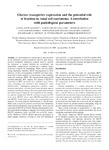Mostrar o rexistro simple do ítem
Glucose transporter expression and the potential role of fructose in renal cell carcinoma: a correlation with pathological parameters
| dc.contributor.author | Antón-Aparicio, Luis M. | |
| dc.contributor.author | Medina Villaamil, Vanessa | |
| dc.contributor.author | Blanco, Moisés | |
| dc.contributor.author | Valbuena Ruvira, L. | |
| dc.contributor.author | Rois, José Manuel | |
| dc.contributor.author | Valladares-Ayerbes, Manuel | |
| dc.contributor.author | García Campelo, Rosario | |
| dc.contributor.author | Bolós Fernández, Victoria | |
| dc.contributor.author | Grande Pulido, Enrique | |
| dc.date.accessioned | 2018-04-30T11:07:20Z | |
| dc.date.available | 2018-04-30T11:07:20Z | |
| dc.date.issued | 2010-07-01 | |
| dc.identifier.citation | Antón Aparicio LM, Medina Villaamil V, Blanco Calvo M, Valbuena Rubira L, Rois JM, Valladares-Ayernes M, et al. Glucose transporter expression and the potential role of fructose in renal cell carcinoma: a correlation with pathological parameters. Mol Med Rep. 2010;3(4):575-580 | es_ES |
| dc.identifier.issn | 1791-2997 | |
| dc.identifier.issn | 1791-3004 | |
| dc.identifier.uri | http://hdl.handle.net/2183/20650 | |
| dc.description.abstract | [Abstract] All mammalian cells contain one or more members of the facilitative glucose transporter (GLUT) gene family. Glucose transporter membrane proteins (GLUT) regulate the movement of glucose between the extracellular and intracellular compartments, maintaining a constant supply of glucose available for metabolism. Tumor cells are highly energy-dependent, therefore GLUT overexpression is often observed. In fact, overexpression of GLUT1 has been correlated with hypoxia markers in several tumor types, including renal cell carcinoma (RCC). We retrospectively analyzed 80 paraffin-embedded RCC samples. The pattern of GLUT1-5 expression in RCC specimens was evaluated using tissue-array technology and correlated with histological tumor characteristics. Pathological parameters included tumor location, renal pelvis, vein and lymph vessel invasion, capsule breakage, histological subtype, Furhman grade, hilar invasion and tumor stage at diagnosis. The expression of five facilitative glucose transporters, GLUT1 (erythrocyte type), GLUT2 (liver type), GLUT3 (brain type), GLUT4 (muscle/fat type) and GLUT5 (small intestinal type), was semi-quantitatively analyzed. In non-parametric, Mann-Whitney U and Kruskal-Wallis tests, a significant positive correlation was consistently found between moderately differentiated RCC tissues and the expression of GLUT5 (p=0.024). Patients who had pelvic invasion and capsule breakage at diagnosis also showed increased GLUT5 expression levels (p=0.039 and p=0.019, respectively). Moreover, GLUT5 showed statistical significance in those samples identified as being of clear cell histological type (p=0.001). A high expression of GLUT5 in human RCC was observed. GLUT5 appears to be correlated with grade II differentiation, locoregional invasion and aggressiveness, and may play a role in RCC development. | es_ES |
| dc.language.iso | eng | es_ES |
| dc.publisher | Spandidos | es_ES |
| dc.relation.uri | http://dx.doi.org/10.3892/mmr_00000300 | es_ES |
| dc.subject | Carbohydrates | es_ES |
| dc.subject | Glucose transporter | es_ES |
| dc.subject | Renal cell carcinoma | es_ES |
| dc.subject | Tissue-arrays | es_ES |
| dc.title | Glucose transporter expression and the potential role of fructose in renal cell carcinoma: a correlation with pathological parameters | es_ES |
| dc.type | info:eu-repo/semantics/article | es_ES |
| dc.rights.access | info:eu-repo/semantics/openAccess | es_ES |
| UDC.journalTitle | Molecular Medicine Reports | es_ES |
| UDC.volume | 3 | es_ES |
| UDC.issue | 4 | es_ES |
| UDC.startPage | 575 | es_ES |
| UDC.endPage | 580 | es_ES |
Ficheiros no ítem
Este ítem aparece na(s) seguinte(s) colección(s)
-
GI-FENM - Artigos [109]






